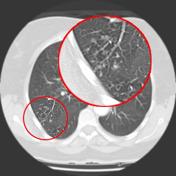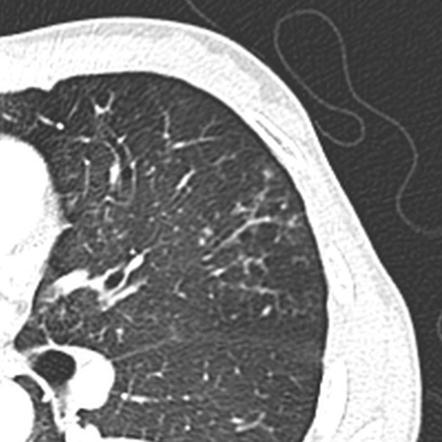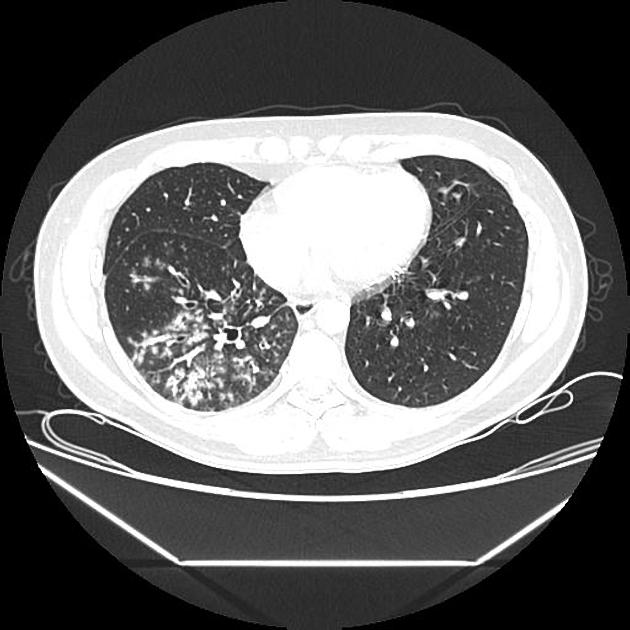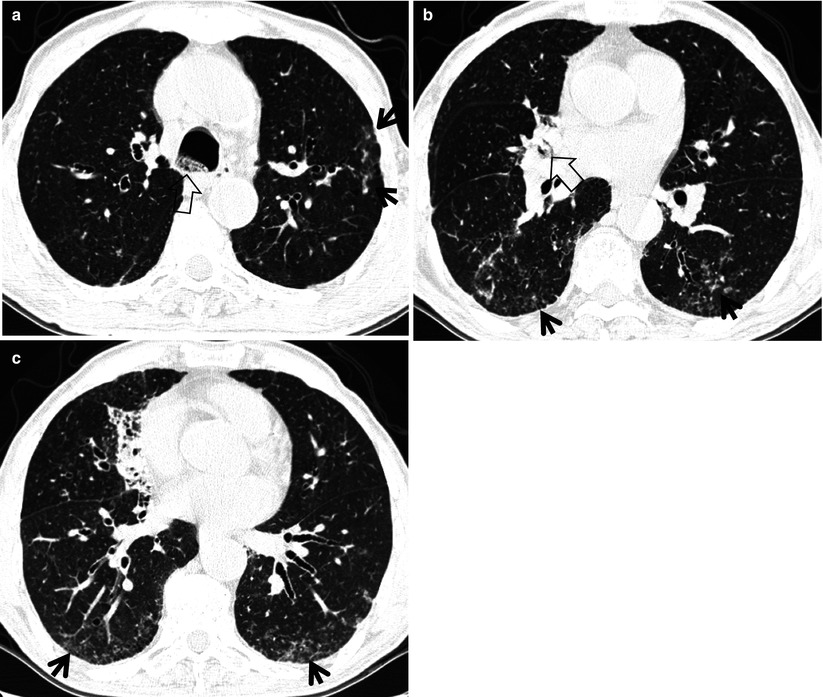tree in bud opacities
Tree-in-bud TIB opacities are a common imaging finding on thoracic CT scan. Tuberculosis many infectious organisms can produce this pattern.

Tree In Bud Sign Lung Radiology Reference Article Radiopaedia Org
Mild bronchiectasis had also been noted Figure 1.

. 32 rows Tree-in-bud TIB opacities are a common imaging finding on thoracic CT scan. Bronchiolitis is characterized at thin-section CT by the presence of centrilobular nodules and linear branching opacities producing a tree-in-bud appearance Fig 7 4. The tree-in-bud pattern suggests active and contagious disease especially when associated with adjacent cavitary disease within the lungs.
We suggest that clusters of micronodules on CT in adult active pulmonary tuberculosis represent aggregated tree-in-bud lesions. 8081 On CT the tree-in-bud pattern manifests as small 24 mm centrilobular well-defined nodules connected to linear branching opacities that. However BAC can occasionally show tree-in-bud pattern ground-glass opacities or crazy-paving pattern.
1 direct filling of the centrilobular arteries by tumor emboli and 2 fibrocellular intimal hyperplasia due to carcinomatous endarteritis. Our Radiology Information System was searched for the term tree-in-bud from January 1 2010 to December 31 2010 identifying 599 examinations. Kanne MD Professor and Chief Thoracic Imaging Univesity of Wisconsin.
This tree-in-bud pattern is due to the presence of caseation necrosis and granulomatous inflammation within and surrounding the terminal and respiratory bronchioles and alveolar ducts reflecting endobronchial spread of tuberculosis. Tree in bud opacification refers to a sign on chest CT where small centrilobular nodules and corresponding small branches simulate the appearance of the end of a branch belonging to a tree that is in bud. Malignancy can be associated with the tree-in-bud sign.
The tree-in-bud sign can be commonly caused by respiratory infections including that of mycobacterial bacterial and viral causes. Intravascular pulmonary tumor embolism often occurs in cancers of the breast liver kidney stomach prostate and ovaries and can lead to the tree-in-bud sign in HRCT 214. The term centrilobular branching opacity is desirable in case the bud is absent.
CT confims numerous centrilobular nodules with opacified distal bronchioles tree-in-bud sign and bronchiectasisThese findings most likely represents pulmonary TB or MAC despite negative induced sputum specimens. In radiology the tree-in-bud sign is a finding on a CT scan that indicates some degree of airway obstruction. The differential diagnosis is lengthy.
Please remember this important caveat though. Multiple causes for tree-in-bud TIB opacities have been reported. Fungal hyphae are often found in the airway lumen Fig 7c.
Although commonly associated with M. The tree-in-bud pattern indicates disease affecting the small airways. Clinical manifestations include acute tracheo-bronchitis bronchiolitis and bronchopneumonia.
Uncommonly this pattern can be seen in other entities that cause luminal impaction bronchiolar dilatation or wall thickening including cystic fibrosis immune deficiency inflammatory bowel disease and diffuse panbronchiolitis. The most common CT findings are centrilobular nodules and branching linear and nodular opacities. These abnormalities were still present on another.
11 TIB opacities represent a central imag- Background. Chest radiography had demonstrated signs of bronchiectasis and several scattered nodules Figure 2. In the hospital MTB cannot be missed.
TIB opacities represent a normally invisible branches of the bronchiole tree 1 mm in diameter that are severely impacted with mucous pus or fluid with resultant dilatation and budding of the terminal bronchioles 2 mm in diameter1 photo. Sarcoidosis another common disease typically shows small nodules in perilymphatic distribution. The tree-in-bud pattern or sign should be used in case of visible tree and bud.
However the most common process leading to this CT appearance is infection. However in some cases nodules occurring in relation to centrilobular arteries may mimic the appearance of the tree-in-bud pattern. The most common CT findings are centrilobular nodules and branching linear and nodular opacities.
Chest x-ray in a 60 year old patient of Asian extraction demonstrates faint reticulonodular opacities. Intravascular pulmonary tumor embolism often occurs in cancers of the breast liver kidney stomach prostate and ovaries and can lead to the tree-in-bud sign in HRCT 214. However to our knowledge the relative frequencies of the causes have not been evaluated.
CT confims numerous centrilobular nodules with opacified distal bronchioles tree-in-bud sign and bronchiectasis. As in this case renal cell carcinoma is one of the most common malignancies that may produce this vascular cause of tree-in-bud pattern. TIB opacities are also associated with bronchiectasis and small airways obliteration resulting in mosaic air trapping.
The tree-in-bud sign has been described in cases of acute aspiration 13. Nodular opacities with tree-in-bud appearance can be associated with other changes in lung parenchyma-such as thickening of the bronchial walls consolidations andor areas of. The tree-in-bud sign is a nonspecific imaging finding that implies impaction within bronchioles the.
Vealed scattered linear nodular and tree-in-bud opacities involving the bilateral apices and the upper middle and lower lobes of the right lung suggestive of bronchiolitis. Multiple causes for tree-in-bud TIB opacities have been reported. A tree-in-bud pattern of centrilobular nodules from metastatic disease occurs by two mechanisms.
I do not believe that the CT findings of COVlD-19 are pathognomonic or different from other causes of acute lung injury. Although initially described in 1993 as a thin-section chest CT finding in active tuberculosis TIB opacities are by. The pattern of the tree correlates to an intralobular inflammatory bronchiole and the bud correlates to inflammatory filling in alveolar ducts.
The tree-in-bud sign has been described in cases of acute aspiration 13. These small clustered branching and nodular opacities represent terminal airway mucous impaction with adjacent peribronchiolar inflammation. Malignancy can be associated with the tree-in-bud sign.

Tree In Bud Pattern Radiology Case Radiopaedia Org

Pdf Tree In Bud Semantic Scholar

Tree In Bud Sign Lung Radiology Reference Article Radiopaedia Org
View Of Tree In Bud The Southwest Respiratory And Critical Care Chronicles

Tree In Bud Sign And Bronchiectasis Radiology Case Radiopaedia Org

Tree In Bud Sign Lung Radiology Reference Article Radiopaedia Org

Chest Ct With Multifocal Tree In Bud Opacities Diffuse Bronchiectasis Download Scientific Diagram

Tree In Bud Appearance Radiology Case Radiopaedia Org

References In Causes And Imaging Patterns Of Tree In Bud Opacities Chest

Tree In Bud Sign Radiology Key

References In Causes And Imaging Patterns Of Tree In Bud Opacities Chest


